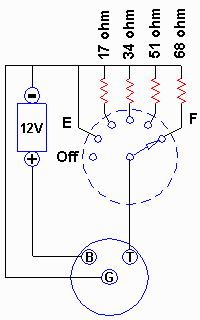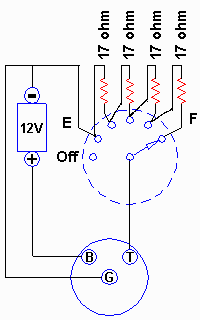Okay, if you're here you didn't take the shortcut, so here come the fun details. After fiddling with a handful of resistors and twisted wires for a while I decided it was too much PITA and took a quick trip to RadioShack for about $10-USD worth of trinkets. Just another half hour of tinkering yielded up the test box shown below. Before I go on here's a full list of materials purchased. Project box, 5 x 2.5 x 2 $3.29
2-pole 6-position rotary switch $1.69
2pcs Plastic knob 1/4 shank $1.29
Coaxial DC power jack 2.5mm $1.69
10pcs 68 ohm 1/2 watt resistor $ .98
5pcs 100 ohm 1/2 watt resistor $ .49
Tax $ .64
Total $10.07
Mind you I didn't use quite all of these bits, but there were some additional materials scrounged from the workshop: |
 Inside rear view of test box with details. |
The power pack was just a matter of convenience for working at my computer table where the digital camera was handy, but you can use any 12 volt DC supply with 300ma capacity (4 watts), which could just as well be your car battery. And in the end you can accomplish the necessary task using just two 68 ohm resistors and jumper wire(s). So for only $0.50 worth of resistors you're in the calibration business. That's why the shortcut was offered after I did the development work. |

